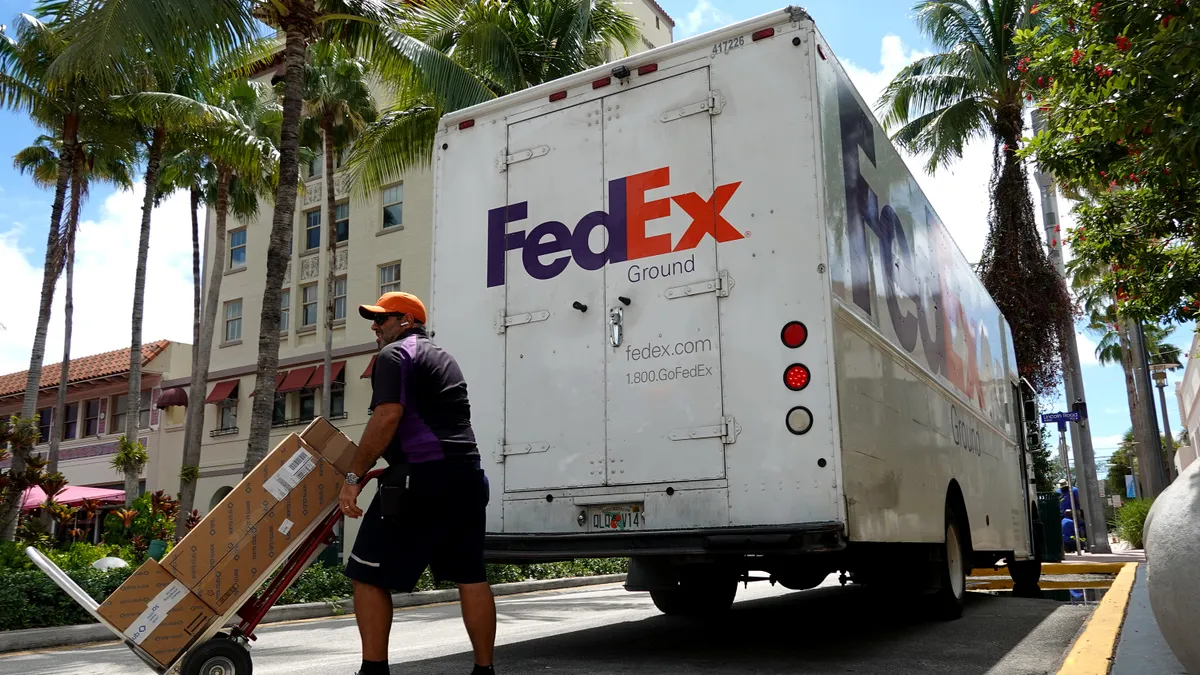Dive Brief:
- Municipalities have a slew of options to cut greenhouse gas emissions from delivery vehicles as more consumers turn to e-commerce, the National League of Cities said in a new action guide.
- Local leaders can adopt delivery-decarbonizing policies such as requirements that deliveries occur during off-peak traffic hours, congestion pricing and zero-emissions delivery zones, which is “the latest, most ambitious approach to incentivizing the electrification of commercial fleets,” the guide says.
- Alternative delivery vehicles exist, but each brings its own challenges and benefits, the guide says. For example, sidewalk delivery robots require minimal labor and don’t contribute to road traffic, but they may not work well everywhere due to complex regulations and a need for strong pedestrian infrastructure.
Dive Insight:
Online purchasing can increase safety, accessibility and convenience for consumers, but the increasing demand for delivery is creating problems in cities nationwide, increasing air pollution, greenhouse gas emissions and traffic congestion, according to the NLC. These impacts are expected to increase in the coming years, the new action guide says: By 2030, congestion from delivery traffic is predicted to add 11 minutes of commute time per person in the world’s 100 largest cities, and emissions from local delivery traffic alone are expected to increase by 32%.
Already, some municipalities are testing or have adopted policies and technologies to ease the burden on communities. Zero-emissions delivery zones, which are areas where access is limited to zero-emission delivery vehicles, have been tested in Santa Monica, California, and will soon be enforced in Portland, Oregon.
Pittsburgh is implementing smart loading zones, which use data collection, sensors and cameras to charge vehicles for by-the-minute parking, rather than the 30-minute blocks that are too long for delivery vehicle needs. “Data is one of the best management tools for designing an effective curb policy,” the NLC action guide says.
Companies are also making moves to change the delivery landscape: Bikeshare provider Gotcha Mobility launched a program in Baton Rouge, Louisiana, allowing businesses to rent e-bikes for a daily fee of $15, rather than the per-minute or hourly charges typically used by bikeshare companies. “For businesses with smaller deliveries, this program enables them to conveniently access electric delivery vehicles at a low cost so that businesses can conduct their own deliveries, rather than having to outsource this service,” the NLC action guide says.
However, the guide says, cities must have the infrastructure to enable new modes of delivery. For example, a safe bike lane network is needed for cargo e-bikes, which can reduce greenhouse gas emissions but carry much less compared with trucks and vans. Aerial drones, an emerging delivery technology that faces regulatory hurdles, will also require new infrastructure, which some local and state governments are already advancing, according to the NLC action guide.
The NLC action guide urges municipalities to carefully consider the best options for their community, presenting key questions such as:
- How will safety be prioritized for pedestrians and delivery workers not in large vehicles?
- Which parts of the city are experiencing the highest incidence of air pollution from vehicles? Do these geographic areas correspond to historically disadvantaged neighborhoods or low-income households?
- How much parking should be available in certain areas? What percentage will be used for deliveries?
“Communicating early and often with local businesses, delivery companies and residents will help municipalities refine and accomplish their goals,” the action guide says.












